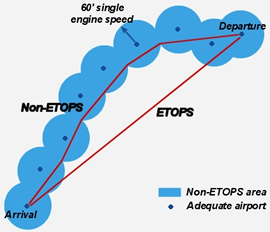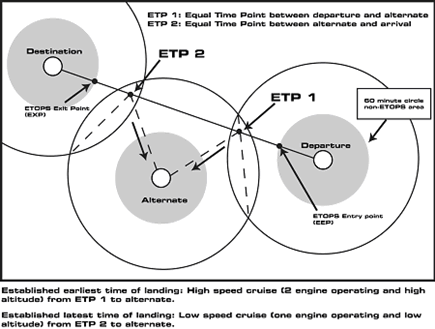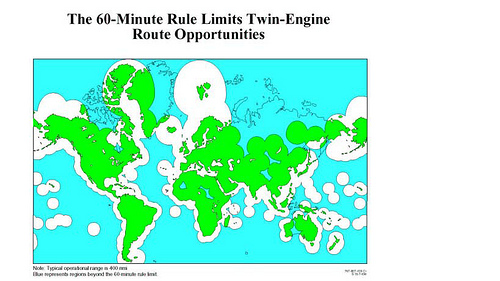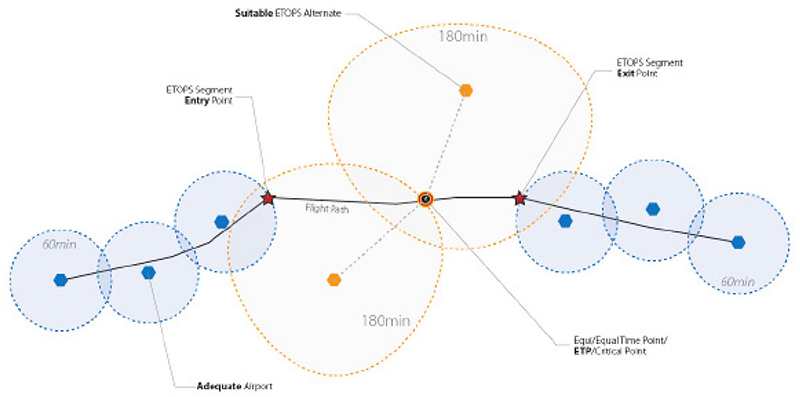¶ Introduction
Extended range operations by aircraft with two turbine power units (ETOPS or EROPS) are sometimes necessary to permit twin engine aircraft to operate over very long sectors where the range from a suitable alternate aerodrome will exceed the maximum laid down in regulations.
This maximum is laid down by national authorities and is normally the distance corresponding to 60 minutes flight time at the single engine cruise speed in still air conditions.
Basically any two-engine aircraft operating for an airline must be within 60 minutes of the nearest suitable airport with one engine inoperative.

Time is always calculated without wind components for ETOPS except for EEP/EXP/ETP points.
¶ Definitions
Adequate Aerodrome: is an airport that meets the landing performance requirements of the aircraft i.e. Runway length, ATC, Lighting, Communications, weather reporting, Navigation Aids, airport facilities and at least one instrument approach. Adequate Airports are selected at the time of planning ETOPS' routes.
Suitable Aerodrome: is an adequate airport which at the anticipated time of use [1 hour before earliest E.T.A. to 1 hour after latest E.T.A.] has weather reports OR forecasts which indicate the weather conditions to be at or above the approved minima.
ETOPS Entry Point (EEP): This point is the start of the ETOPS segment exactly one hour (60 minutes in still air, single engine) from a suitable aerodrome.
ETOPS Exit Point (EXP): This point is the point on route when the ETOPS segment ends.
ETOPS Equal Time Point (ETP): Equal time point between two suitable diversion alternates.
Critical Fuel Scenario: fuel required assuming a normal flight and 3 different scenarios: Engine fail, depressurization and engine failure with depressurization. The one that requires more fuel will be elected as the required critical fuel scenario.

¶ ETOPS Safety Margin
In 1985, ICAO and FAA issued guidelines for extended range operations for twin engine planes. The FAA promulgated conditions that need to be fulfilled for a grant of a 120 minutes diversion period. The aircraft can be 2 hours from an alternate airport, which is sufficient for direct transatlantic flights, and other aviation authorities worldwide followed.



In white colour, the zone over the oceans which follows the requirements of the diversion period.
ETOPS ratings are also granted for 180 minute and 240 minute diversion periods. ETOPS-180 is only possible after 1 year of trouble-free 120-minute ETOPS experience.
The current approval standard for 180-minute ETOPS is 0.02 shutdowns per 1,000 hours of engine operation. That amounts to an in-flight shutdown rate of one every 50,000 hours. This level of demonstrated safety has prompted many operators and authorities to opt for longer planned diversion times, from 240 minutes to virtually "unrestricted" ETOPS.
Statistically, twin engine planes have a lower likelihood of a diversion compared to 3 or four engine planes. It is important to know that extending ETOPS durations may compromise the safety of a flight, since an adequate safety margin should be ensured to make sure the plane can land at the nearest airport in the case of an emergency.
¶ ETOPS Weather Minima
Weather minima for airports designated as suitable en-route alternates under ETOPS Regulations are prescribed below. It must be noted that the minima shown hereafter are for despatch release purposes only and in the event of an actual diversion; the applicable landing minima for that airport will be the controlling factor.
¶ Airports with 2 or more ILS on separate runways:
- Ceiling of 400ft and visibility of 1600m or
- Ceiling of 200ft and visibility of 800m above the authorized ILS landing minima.
¶ Airports with ILS on a single runway:
- Ceiling of 600ft and visibility of 3200m or
- Ceiling of 400ft and visibility of 1600m above the authorized ILS landing minima.
¶ Airports with non - precision approaches:
- Ceiling of 800ft and visibility of 3200m or
- Ceiling of 400ft and visibility of 1600m above the authorized non precision landing minima; whichever is higher.
¶ ETOPS Critical Fuel Scenario
The minimum required fuel for an ETOPS flight will be the highest between the standard fuel planning versus the ETOPS fuel planning.
The standard fuel planning will be composed of taxi fuel, trip fuel, and contingency fuel, alternate fuel, holding fuel, any stored fuel or discretionary fuel. ETOPS will be integrated by the standard fuel scenario and the critical fuel scenario.
The critical fuel scenario will be applied from the Critical Point to the diversion alternate. This critical fuel scenario is based upon failures (Engine failure or Depressurization) that could happen at the critical point; it is critical due to the fact that in terms of fuel planning a diversion at this point is not favorable.
Critical fuel scenario will take into account the diversion profile and its necessary variables, those variables will consist of:
- Descent at pre-determined speed to the required diversion flight level.
- Cruising phase at a pre-determined speed.
- Descent to 1500ft above the diversion alternate.
- 30 minutes of holding at 1500ft.
- First approach (IFR procedure) and go/around.
- Second approach (VFR procedure) and landing manoeuvre.
¶ ETOPS Failure Scenarios
ETOPS could be calculated based on two scenarios:
- Aircraft depressurization
- Aircraft depressurization and Engine Failure
¶ Aircraft depressurization:
Pilots should take into account the following factors.
- Emergency descent (VMO/MMO with speed-brakes extended) to FL100 or grid MORA (whichever is higher)
- Diversion cruise phase at LRC (Long Range Cruise) speed.
¶ Aircraft depressurization and Engine Failure:
Pilots should take into account the following factors.
- Emergency descent (VMO/MMO with speed-brakes extended) to FL100 or grid MORA (whichever is higher); at the same time it's necessary to be familiar with the aircraft limitations established in the manufacturer manual (FCOM, FCTM and QRH).
- Diversion cruise phase at schedule speed at the area of operation, taking into account the limitations established for the cruise phase with just one engine.
The scenario resulting in the highest amount of fuel will be referred as the ETOPS CRITICAL FUEL SCENARIO. It is important for the pilot to be familiarized with the aircraft manuals in order to compare the dispatch information.
¶ ETOPS Critical Fuel Reserves
Regulations require the addition of a certain fuel quantity (reserves) to the ETOPS diversion fuel:
- Fuel from the critical point to the diversion airport.
- 5% contingency (based upon the CP to the diversion alternate).
- 30 minutes of holding at 1500ft (minimum manoeuvring speed).
- IFR approach plus a go around procedure.
- VFR approach.
- MEL (Minimum equipment list) penalty fuel.
- In case there's a prevailing icing condition: 1.3% should be taken in order to achieve the fuel demand affected by the engine/wing nacelle anti-ice.
- APU usage in case that it will be used as power source.
¶ ETOPS Flight Monitoring and Decision Making
During the course of the flight, the flight crew should be informed about any significant changes in the conditions at the designated ETOPS en-route alternates.
¶ Special considerations before the ETOPS Entry Point:
Before the EEP, crew must be notified of any significant changes about: forecast weather, aerodrome availability and any other factors that could affect the safety of the ETOPS flight. Crew must check any changes that would affect the approach and landing at an ETOPS alternate airport; pilot must check the minima at the diversion airfields and in case that it's affected an appropriate course of action must be taken if normal minima do not fulfill the expectations before the EEP. If necessary another ETOPS alternate, re-routing or turn back should be considered.
¶ Flying the ETOPS sector:
Normal flight monitoring will be applied, pilots must be aware of the situation at their alternate aerodromes; fuel management techniques shall be applied in order to ensure a good distribution of the fuel.
¶ Deviation from the planned ETOPS route:
The commander will not accept an ATC clearance that would take the flight outside of the authorized area of operations. If a deviation is required from the planned route of flight, the crew will verify that the revised route remains within the cleared area of operation of the designated ETOPS en-route alternates, and if a change is necessary another alternate aerodrome within the authorized area of operation shall be designated.
¶ Diversion
When the aircraft is in the ETOPS sector of the flight and a selected ETOPS en-route alternate becomes unsuitable, the pilot will designate another aerodrome where a safe landing can be made. If this is not possible then the commander should take an appropriate course of action. No diversion procedure is specified for ETOPS, this will vary according to the aircraft model, in case of an emergency situation the pilot should LAND ASAP.

- None
- None
- VID 250741 - Creation
- VID 256272 - Wiki Integration
- VID 496402 - Wiki.js integration